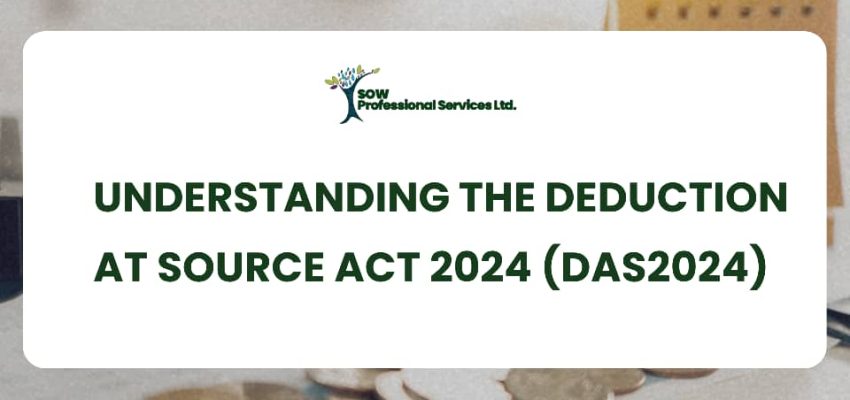Understanding the Deduction at Source Act 2024 (DAS2024)
Understanding the Deduction at Source Act 2024
(DAS2024)
Before the introduction of the Deduction at Source Act 2024 (DAS 2024), the withholding tax
framework in Nigeria was scattered across multiple laws, including CITA, PITA, CGTA,
and PPTA. Each carried its own provisions, rates, and exemptions, often creating confusion,
compliance bottlenecks, and conflicting interpretations.
The DAS2024 changes that narrative. It consolidates all deduction-at-source rules under one
law, simplifying administration and ensuring uniform treatment of both individuals and
corporations. Its purpose is similar in spirit to the National Tax Administration Act 2025
(NTA2025), which later unified tax administration procedures across all major taxes.
However, while the NTA2025 focuses more on administrative coordination, DAS2024 targets the
mechanics of deduction itself, just like the Nigeria Tax Act 2025, making compliance smoother,
fairer, and traceable from the source of payment.
Policy Intent and Objectives
The objectives of the DAS2024 reflect a policy shift from revenue collection to compliance
efficiency. It seeks to extensively simplify the deduction of tax at source, reduce the rates for
certain sectors in relation to current economic realities, while providing exemptions for small
businesses under specific conditions. Tax evasion is expected to be minimized with this new
regulation.
The underlying goal is to make the system simpler to operate and more equitable, especially for
sectors that previously bore disproportionate deduction rates.
From Fragmentation to Unification
Before DAS2024, withholding tax deductions were governed separately under different tax laws.
For instance, CITA applied to companies, PITA to individuals, CGTA to capital transactions, and
PPTA to petroleum operations. Each law had its own rate, scope, and timeline, which
complicated compliance and often resulted in double deductions or inconsistent treatments
across jurisdictions.
DAS2024 unifies these fragmented rules. It introduces a single deduction framework that
applies across sectors and taxpayer categories, making withholding administration clearer for
both tax authorities and businesses.
Rate Adjustments and Key Harmonizations
The Act also adjusted deduction rates and introduced uniformity where discrepancies previously
existed:
● Contract, consultancy, and professional services now attract a unified 5% rate for
both companies and individuals (previously ranged between 5% and 10%).
● Dividends, interest, and royalties remain at 10%, but clearer exemptions apply to
intra-group transactions and reinvested income.
● Rent, lease, and equipment hire are harmonized at 5%, eliminating the previous
variations under CITA and PITA.
● Commission, brokerage, and agency fees now attract a flat 5%, regardless of the
nature of the payer.
● Small businesses and manufacturers benefit from explicit exemptions, as outlined
under Section 3(d), in line with the government’s drive to ease the tax burden on
productive enterprises.
These harmonizations help reduce ambiguity and make the withholding system more reflective
of actual economic margins across sectors.
Relationship with the NTAA2025
While the NTAA2025 does not directly override DAS2024, some of its provisions could create
points of friction. For instance, under Section 3(c) of DAS2024, a taxpayer who engages a
person or entity without a Tax Identification Number (TIN) is obligated to deduct at twice the
normal rate; on the other hand, the NTA2025 is stricter, as it clearly penalizes taxable persons
who transact with unregistered entities. This creates a slight divergence between both Acts,
since DAS2024 focuses on deduction adjustment for non-TIN holders, while NTA2025
introduces penalties tied to registration and compliance status.
The broader policy takeaway is that both reforms aim for the same end: universal tax identity,
electronic traceability, and accountability. However, harmonization between them will be
essential to avoid administrative conflicts during implementation.
From Collection to Compliance Efficiency
By consolidating deduction rules, simplifying rates, and clearly defining exemptions, the
DAS2024 promotes efficiency over complexity. It ensures that tax is deducted correctly and
remitted on time, typically within 21 days, while removing the ambiguities that plagued earlier
regimes.
It also curbs tax arbitrage between incorporated and unincorporated entities, as both are now
subject to similar treatment under the same deduction rules.
Conclusion
The Deduction at Source Act 2024 represents one of the most practical structural reforms in
Nigeria’s tax system. It simplifies compliance, rationalizes rates, and fosters administrative
consistency. Even though some provisions of the NTAA2025 may overlap or conflict with it, both
laws share a unifying spirit.
Ultimately, DAS2024 sets the groundwork for a more transparent, technology-driven tax
environment, where deduction, remittance, and identity validation operate under one consistent
and predictable framework.
To find out more about Understanding the Deduction at Source Act 2024 (DAS2024)”
kindly contact us at :
E-mail: care@sowprofessional.com
Website: www.sowprofessional.com
Whatsapp: 07038254989
Phone: 08152451523




